
NeighborHoodies: A Preschool Card Game Review
NeighborHoodies is a delightful card game that's quickly become a favorite in our house. My 5 and 7-year-olds are completely captivated, and honestly, so am I! It's deceptively simple: match adorable animal characters to their equally adorable hoodies. But here's the clever twist: you can't place matching pairs next to each other. This seemingly small rule adds a surprising layer of strategic thinking, turning a simple matching game into a playful puzzle. My kids, especially my seven-year-old, are constantly strategizing their next move, making it a surprisingly engaging experience for them. The constant back-and-forth creates a fun, playful competition, leaving them practically begging for another round!
What makes NeighborHoodies truly special is its subtle brilliance. It's incredibly easy for even the youngest players to pick up, focusing on visual recognition—a critical skill for preschoolers. Yet, beneath the surface of simple matching, lies a sneaky workout for little brains! Planning moves and avoiding those pesky matching neighbors subtly introduces strategic thinking and problem-solving, laying the groundwork for more complex games in the future. It’s a brain-boosting exercise cleverly disguised as pure, unadulterated fun! Did you know that studies show that playful learning significantly improves cognitive development in young children? NeighborHoodies seems to effortlessly tap into this crucial concept.
The real magic of NeighborHoodies lies in its seamless blend of education and entertainment. It strengthens visual memory and perception naturally, without feeling like a lesson. The act of sorting and arranging the cards also subtly strengthens number recognition and counting skills. My kids are completely oblivious to the learning process; all they know is they're having an absolute blast! This is the very essence of effective early childhood education: learning through play.
The preschool game market is undeniably crowded, but NeighborHoodies stands out. While many games aim for complexity, NeighborHoodies embraces simplicity. This translates to shorter, more manageable game sessions— a huge plus for busy families! The charming character designs are the icing on the cake, making it even more appealing to young children. Although similar matching games exist, few offer such a clever gameplay twist and such adorable characters.
Here's a quick breakdown of the pros and cons from a parent's perspective:
| Pros | Cons |
|---|---|
| Exceptionally simple rules; perfect for preschoolers | Limited replay value after mastering core mechanics |
| Appeals to a range of ages within the target demographic | May need some adult guidance initially to explain the rules |
| Develops visual perception, memory, and problem solving | Can get quite loud and energetic during gameplay! |
| Highly portable; ideal for travel | May not hold a child's interest for several years |
| Adorable and engaging art style |
So, is NeighborHoodies worth it? Absolutely! It's a fantastic game that effortlessly blends learning and fun. My kids are obsessed, and I love that it's secretly doing wonders for their cognitive development. The ease of play is a major advantage, making it accessible to multiple players over a couple of years. While it may not become a lifelong fixture in our game cupboard, it’s a fantastic addition to spark family fun and learning during those precious playtime moments. Its blend of engagement, education, and pure fun is precisely what makes it a joyful addition to our family.
How to Use NeighborHoodies Card Game to Teach Preschoolers Problem Solving
Key Takeaways:
- NeighborHoodies offers a playful and effective way to build problem-solving skills in preschoolers (ages 5-7).
- Its simple rules ensure easy engagement for young children.
- The game fosters strategic thinking, collaboration, and decision-making.
- Its engaging nature keeps children motivated and eager to learn.
- NeighborHoodies seamlessly complements other learning methods.
NeighborHoodies isn't just about matching cards; it's a vehicle for developing crucial cognitive skills.
Understanding the Game Mechanics
NeighborHoodies features colorful cards illustrating neighborhood characters and scenes. Children match these characters to appropriate settings. Simple? Absolutely. But the strategic element is where the learning begins. Multiple solutions often exist, compelling kids to think creatively and explore various possibilities. This encourages out-of-the-box thinking and reinforces flexible problem-solving strategies.
How to Use NeighborHoodies for Problem Solving
To maximize NeighborHoodies' educational potential:
- Start Simple: Begin with basic matching, gradually progressing to more intricate challenges.
- Increase the Challenge: Introduce time limits or competitive elements as skills develop.
- Promote Collaboration: Play together, encouraging discussion and sharing of strategies. Ask open-ended questions like, "What's your plan?" or "Why did you choose that card?"
- Post-Game Reflection: Debrief after each game, analyzing successes and challenges. Discuss alternative approaches and successful strategies.
- Adjust Difficulty: Adapt the game's complexity to match your child's abilities, celebrating both big and small wins to build confidence.
NeighborHoodies: Pros and Cons
| Feature | Pros | Cons |
|---|---|---|
| Gameplay | Engaging, easy to learn, adaptable to different skill levels. | Can become repetitive without introducing variations. |
| Educational Value | Enhances problem-solving, matching, and strategic thinking. | Limited scope if not combined with other learning activities. |
| Fun Factor | Colorful, playful design encourages interaction and joyful competition. | Individual preferences may vary; not all children may find it equally appealing. |
NeighborHoodies and Cognitive Development
NeighborHoodies aligns perfectly with proven play-based learning methods for preschoolers. This approach boosts confidence in problem-solving and promotes experimentation without fear of failure. It’s a reminder that learning is a journey, not a race to the finish line.